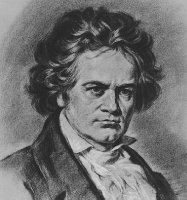![]()


|
Ludwig van Beethoven op. 90, sonata for piano in e minor, edition Peters edited by Claudio Arrau. This is one of my favorites. Listen in Real Audio |
This page is maintained by Bob Weeks of Wichita, Kansas, USA.

|
Ludwig van Beethoven op. 28, sonata for piano in d ("Pastorale"), second movement in d minor. This movement was a favorite of Beethoven's, one that he would play for friends. Listen in Real Audio |
|
Many, many composers have been able to write heavenly tunes and respectable fugues. Some composers can orchestrate the C-major scale so that it sounds like a masterpiece, or fool with notes so that a harmonic novelty is achieved.
But this is all mere dust—nothing compared to the magic ingredient sought by them all: the inexplicable ability to know what the next note has to be.
Beethoven had this gift in a degree that leaves them all panting in the rear guard. Beethoven broke all the rules, and turned out pieces of breath-taking rightness. Rightness—that's the word! When you get the feeling that whatever note succeeds the last is the only possible note that can rightly happen at that instant, in that context, then chances are you're listening to Beethoven. Melodies, fugues, rhythms—leave them to the Chaikovskys and Hindemiths and Ravels. Our boy has the real goods, the stuff from Heaven, the power to make you feel at the finish: Something is right in the world. There is something that checks throughout, that follows its own law consistently: something we can trust, that will never let us down. From Leonard Bernstein's "The Joy of Music" (Simon & Schuster, 1960) |

|
Ludwig van Beethoven op. 53, sonata for piano in c ("Waldstein"), excerpt from third movement. Beethoven's music, to me, is not for those looking for plush, beautiful melodies. I've found some of it, like this episode, quite agitating. Listen in Real Audio |

|
The ending of op. 31 no. 2 (first movement), sonata for piano in d minor. Also known as the Tempest, this is one of Beethoven's tragic sonatas. The bass rumbles like thunder in the distance. Listen in Real Audio |

|
The trio from the scherzo of sonata for piano, op. 2 no. 3, in c major. I didn't believe this the first time I heard it. Listen in Real Audio |

|
The beginning of op. 22 (first movement), sonata for piano in b flat. Of this movement Beethoven said "This takes the cake." Listen in Real Audio |
Sign my guestbook, view my guestbook
|
|
The Beethoven IRC Page is part of
The
Classical Music Web Ring
The free linking service hosted by
Classical Music UK
Show me: [ Previous ]
[ Random ]
[ Next ]
[ Next 5 ]
[ All ]
Mail me at bob.weeks@cox.net.
Disclaimer,
Voice For Liberty in Wichita,
my personal page,
my humorous and funny old postcards page.
![]()
Humorous and funny old postcards